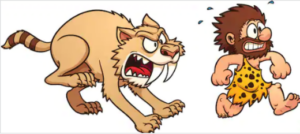If the human body was meant to run, why do so many joggers and runners get all sorts of injuries?
This includes “runner’s knee,” shin splints and foot issues.
Actually, the human body was designed for running – but this premise needs to be taken within a lot of context.
If all a primitive human being did was walk, we would have never survived as a species.
Yet runners – ranging from elite (long and short distance), to fitness motivated are so often hampered with injuries.
So what’s the deal, then?
“In my opinion, humans…and for that matter, no animal, is meant to run long distances,” begins Barbara Bergin, MD, an orthopedic surgeon at and co-founder of Texas Orthopedics, Sports & Rehabilitation Associates.
The exception may be packs of wolves when following a herd of prey, covering up to 30 or so miles per day.
BUT…this would be at about 5 mph – practically a walk to an animal that can sprint up to 45 mph for short distances.
“Name me an animal which runs a 5K, 10K, half-marathon or full marathon on any regular basis,” continues Dr. Bergin.
“Most animals which run are built to run short distances.”
This is very evident on any animal TV show that captures generous footage of predators stalking and then chasing after prey.
Because They Can Doesn’t Mean It’s Harmless
Dr. Bergin, and accomplished horsewoman, explains, “Horses can be forced to run long distances, but they will eventually go lame if it’s done too much, because they are not built for this kind of thing day in and day out.
“And if left to its own devices, it will walk around slowly, eating grass most of the day, sleep a little, and run only to get away from something trying to kill it…or mate with it when it doesn’t feel like mating.
“I have a horse on whom I have won a lot of money and awards doing a high-speed sport, which requires that he run a lot in training.
“He does not choose to do this. He now has an injury to a ligament [which does not prevent him from running], and is recovering at my ranch.
“Since he’s been out there, I have seen him run only once, when he snuck around me to get into another pasture.
“He mostly walks…and very slowly. There’s nothing trying to kill him, so there’s no need to run.
“And if asked, we would certainly say that horses are ‘meant to run.’
“Humans are no different. We’re built to run short distances…in order to kill something or keep from getting killed.

Shutterstock/Memo Angeles
“Natural humans do not run long distances. They can’t. They don’t eat enough food for that. Natural humans are walkers…hunter-gatherers.”
Now wait a minute – wouldn’t too much food hinder the ability to run long distances nonstop?
After all, how many competitive 5K or 10K runners, let alone marathoners, are husky? Shouldn’t they be very lightweight? Keep reading!
Primitive man walked long distances and slowly to prevent missing out on food sources, says Dr. Bergin.
This was to spare what little stored energy that primitive peoples (and modern-day hunter-gatherers) had.
“The only reason humans can electively run long distances now, is because we are able to store lots of energy…from our plentiful food sources!”
Primitive man didn’t have the luxury to “carb load” on pasta and potatoes in the days preceding a long exhausting hunt. He didn’t have sugary power bars and high carb sports drinks.
“Since the human body is not meant to run long distances, it might be easier to see why we suffer so much when we force ourselves to do it.”
Competitive distance runners, and those who jog long distances for fitness or weight management, take on mileage that far exceeds what cave peoples did for survival.
When the food was caught or the danger was gone, ancient man ceased running. Modern man runs at volumes that would seem insane to a cave dweller.
A Fat and Happy Horse
“In a natural world, a horse would likely only live a few years. They eventually become lame from sprinting away from predators, or a traumatic injury or a twisted intestine, and once that happens, it’s all over.
“I’ve been competing in high impact/high speed horse events for a long time, and sadly, I’ve been responsible for creating lame horses.
“But…when I create a lame horse, they get to go live the rest of their lives at my ranch… without a worry in the world. And they live a long time.
“Once they stop the forced exercise, they get better. They might have the tiniest limp, but they are fat and happy.
“So, given the opportunity to walk around, that’s what horses do.
“But humans are different. We force ourselves to exercise and even over-exercise.
“We exercise when we’re injured and in pain! We do exercises while our joints pop and grind, and then we expect them to hold up until we’re 90.
“Humans are natural, long distance, slow walkers. When we stray from this, we suffer.”
It’s not the Race that Causes Injuries; It’s the Training

Freepik.com/ijeab
Long distance runners may run 10-15 miles nearly every day – at a painful pace at that. And on hard concrete. No wonder so many runners get chronic injuries.
Competitive sprinters, as well, are laden with injuries. The race may last 10 seconds to under a minute.
But the training is fierce – five or six days a week on an asphalt track, sprinting over and over and over.
What about injuries in non-competitive runners and slow joggers who don’t even cover that much mileage?

Many people who jog for exercise don’t start till later in adulthood. They’ll be more prone to injuries than if they’d been running since childhood on a consistent basis – and as their primitive ancestors did.
The older body that begins a jogging regimen will have a higher risk of developing chronic injury.
Another point to consider is excess weight. Excess weight is bad enough on the knees and feet when just walking.
The risk of chronic injury is amplified when a hefty person jogs.
This isn’t to say that nobody should ever run, even to lose weight.
But people need to listen to their bodies and obey them!
Humans Are Natural Runners
A report explains that endurance running was key to survival. Humans can outrun most other mammals when it comes to long distances, due to our very efficient cooling physiology (e.g., no fur, lots of sweat glands).
Some studies suggest that primitive man jogged for long distances in pursuit of prey until the prey overheated and was easy to slaughter.
This “persistence hunting” is seen in modern-day hunter-gatherers like the Bushmen of Africa.
The main butt muscle, the gluteus maximus, is minimally used when walking. It’s a running muscle, not a walking muscle.
Our bodies have many features that make us naturally efficient at running – for survival.
But persistence hunting on soft earth doesn’t compare to training on asphalt for long distance races.
The injuries arise when, as mentioned, we run for competition, weight loss and fitness rather than for survival.



























